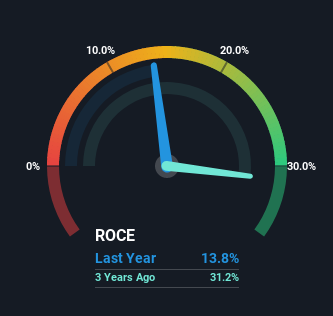Some Investors May Be Worried About Associated Alcohols & Breweries' (NSE:ASALCBR) Returns On Capital
If we want to find a stock that could multiply over the long term, what are the underlying trends we should look for? One common approach is to try and find a company with returns on capital employed (ROCE) that are increasing, in conjunction with a growing amount of capital employed. This shows us that it's a compounding machine, able to continually reinvest its earnings back into the business and generate higher returns. Although, when we looked at Associated Alcohols & Breweries (NSE:ASALCBR), it didn't seem to tick all of these boxes.
Understanding Return On Capital Employed (ROCE)
Just to clarify if you're unsure, ROCE is a metric for evaluating how much pre-tax income (in percentage terms) a company earns on the capital invested in its business. Analysts use this formula to calculate it for Associated Alcohols & Breweries:
Return on Capital Employed = Earnings Before Interest and Tax (EBIT) ÷ (Total Assets - Current Liabilities)
0.14 = ₹521m ÷ (₹4.9b - ₹1.1b) (Based on the trailing twelve months to December 2022).
So, Associated Alcohols & Breweries has an ROCE of 14%. In absolute terms, that's a pretty normal return, and it's somewhat close to the Beverage industry average of 15%.
Check out our latest analysis for Associated Alcohols & Breweries

While the past is not representative of the future, it can be helpful to know how a company has performed historically, which is why we have this chart above. If you're interested in investigating Associated Alcohols & Breweries' past further, check out this free graph of past earnings, revenue and cash flow.
What The Trend Of ROCE Can Tell Us
On the surface, the trend of ROCE at Associated Alcohols & Breweries doesn't inspire confidence. Over the last five years, returns on capital have decreased to 14% from 33% five years ago. Although, given both revenue and the amount of assets employed in the business have increased, it could suggest the company is investing in growth, and the extra capital has led to a short-term reduction in ROCE. And if the increased capital generates additional returns, the business, and thus shareholders, will benefit in the long run.
On a related note, Associated Alcohols & Breweries has decreased its current liabilities to 22% of total assets. That could partly explain why the ROCE has dropped. Effectively this means their suppliers or short-term creditors are funding less of the business, which reduces some elements of risk. Since the business is basically funding more of its operations with it's own money, you could argue this has made the business less efficient at generating ROCE.
Our Take On Associated Alcohols & Breweries' ROCE
Even though returns on capital have fallen in the short term, we find it promising that revenue and capital employed have both increased for Associated Alcohols & Breweries. And long term investors must be optimistic going forward because the stock has returned a huge 123% to shareholders in the last three years. So should these growth trends continue, we'd be optimistic on the stock going forward.
On a final note, we've found 2 warning signs for Associated Alcohols & Breweries that we think you should be aware of.
While Associated Alcohols & Breweries isn't earning the highest return, check out this free list of companies that are earning high returns on equity with solid balance sheets.
New: Manage All Your Stock Portfolios in One Place
We've created the ultimate portfolio companion for stock investors, and it's free.
• Connect an unlimited number of Portfolios and see your total in one currency
• Be alerted to new Warning Signs or Risks via email or mobile
• Track the Fair Value of your stocks
Have feedback on this article? Concerned about the content? Get in touch with us directly. Alternatively, email editorial-team (at) simplywallst.com.
This article by Simply Wall St is general in nature. We provide commentary based on historical data and analyst forecasts only using an unbiased methodology and our articles are not intended to be financial advice. It does not constitute a recommendation to buy or sell any stock, and does not take account of your objectives, or your financial situation. We aim to bring you long-term focused analysis driven by fundamental data. Note that our analysis may not factor in the latest price-sensitive company announcements or qualitative material. Simply Wall St has no position in any stocks mentioned.
About NSEI:ASALCBR
Associated Alcohols & Breweries
Engages in liquor manufacturing, distillation, and bottling activities in India and internationally.
Solid track record with excellent balance sheet.
Market Insights
Community Narratives



